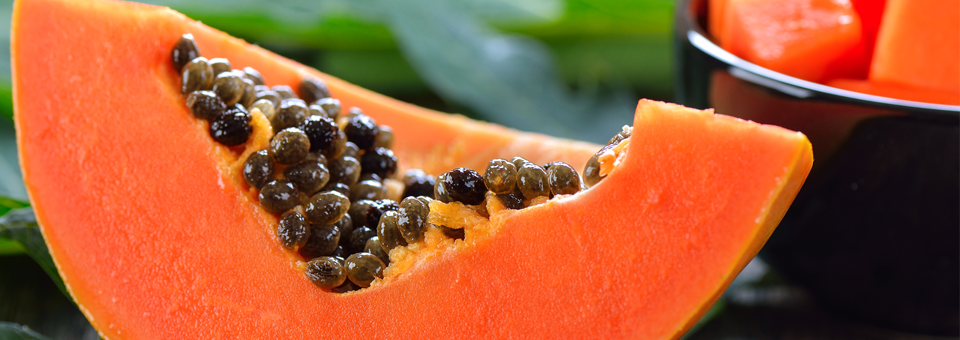
Bali holds a special place in my heart.
When I was a young boy my father told me tales of this island paradise from his World War II days.
He painted an amazing picture of endless beaches, impenetrable jungles and the warm, generous people who lived there.

The papaya trees in Bali are bigger and taller than any I’ve ever seen
anywhere else.
When I finally arrived in Bali many years later it took my breath away.
Everything was lush and brighter… and bigger than I imagined.
Like the papaya trees on the island. Now, living in South Florida, papaya trees are common. But the papaya tree in my friend Lelir’s garden was bigger and wider than any papaya tree I’d ever seen.
Lelir called it by the Balinese name Gedang.
This tree was so big I couldn’t get it into one photo. I had to take out my video camera and climb to the top of a hill to record it because I knew no one would believe me.
Here in the States, most people only know the delicious fruit of these trees. But in Bali the traditional healers called “Balians” use all parts of the papaya tree – including the sap – as powerful medicine.
Lelir told me how once she broke open some leaves and applied the sap to her son’s arm to heal a scorpion bite.
Balinese also use papaya to aid digestion… relieve constipation… treat diarrhea… and prevent malaria.1 Exciting new research even proves that the leaves of the papaya tree contain an anti-cancer extract. Studies prove that papaya leaf extract and the seeds suppress tumor cell growth… and stimulate your body’s natural anti-tumor defenses.2
But Lelir also uses papaya as a beauty treatment.
Modern science backs up Lelir on the anti-aging benefits of papaya. For one thing, papaya is loaded with vitamin C, a powerful antioxidant.
The vitamin C in papaya guards your telomeres, the protective caps on the ends of your DNA. The shorter your telomeres, the older your cells act. Those older cells lead to wrinkles, dull skin and all the other annoying signs of aging.
A Japanese study tested vitamin C on telomeres. Raising the level of vitamin C in cells slowed down the shortening of telomeres by up to 62%.3
Another study found that skin cells treated with vitamin C kept their young, firm shape. It slowed the shortening of the cell’s telomeres. The telomeres also suffered less damage in the presence of vitamin C.4
Vitamin C also repairs and rebuilds your skin’s collagen. It promotes skin elasticity and firmness. And it can smooth fine lines and wrinkles, even out skin tone and fade age spots.
Papaya offers much more than vitamin C. It contains “papain.” This enzyme cools inflammation, reduces pain from sunburn and helps heal acne, rosacea and eczema. And it can help lighten skin and reduce the visibility of blemishes, age spots and acne scars.
Papaya also has alpha-hydroxy acids. These gentle acids exfoliate skin and help dissolve dead skin cells. They leave your skin soft, smooth and supple. These are just some of the reasons that papaya is one of the best fruits for an anti-aging facial mask. It cleanses and exfoliates your skin and leaves it firm and glowing.
You can also make your own papaya facial mask at home. Here’s my favorite recipe. I recommend you use it once or twice a week.
Papaya Anti-Aging Face Mask
Ingredients:
- 1 organic payaya
- 1 egg white
- 1 tsp. lemon juice
Directions:
- Peel a ripe, firm papaya and remove the seeds. Puree in a blender until smooth.
- Whisk the egg white until frothy.
- Add the egg white to the papaya and mix well.
- Apply the mixture to your face and neck. Massage gently into skin. Let dry for 15 minutes.
- Rinse off with warm water. Gently pat dry with a soft towel.
To Your Good Health,
![]()
Al Sears, MD, CNS
1 Bhat, G.P. and Surolia, N. “In vitro antimalarial activity of extracts of three plants used in the traditional medicine of India.” Am J Trop Med Hyg. 2001; 65(4): 304-308.
2 Otsuki N, Dang NH, Kumagai E, Kondo A, Iwata S, Morimoto C. “Aqueous extract of Carica papaya leaves exhibits anti-tumor activity and immunomodulatory effects.” J Ethnopharma. 2010;127(3):760-7.
3 Furumoto K. et al. “Age-dependent telomere shortening is slowed down by enrichment of intracellular vitamin C via suppression of oxidative stress.” Life Science 1998; vol. 63, no. 11 pp. 935-48.
4 Yokoo S, et al. “Slow-down of age-dependent telomere shortening is executed in human skin keratinocytes by hormesis-like-effects of trace hydrogen peroxide or by anti-oxidative effects of pro-vitamin C in common concurrently with reduction of intracellular oxidative stress.” J Cell Biochem. 2004;93(3):588-97.








